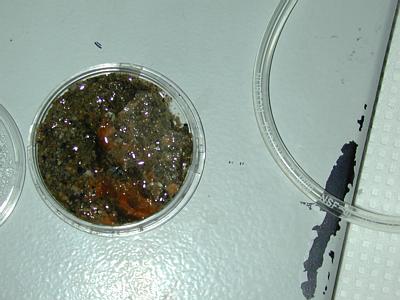26 November, 1999
How is climate change influenced by bio-production?
Dr. Mark Wells spoke with our workshop group today. He is a biological and
chemical oceanographer who is interested in the effects of bio-production on
the reconstruction of the paleo-climate. He presents a compelling case for
looking at changes in bio-production in the oceans as influenced by trace
metals.
One can ask, "Did increase in bio-production cause a change in the climate?
"
One way to look at past climate is to measure the nitrogen in the core
samples taken. Using nitrogen as an indicator, and the fact that there is a
known ratio of heavy nitrogen ( N15) compared to normal nitrogen (N14) in
the atmosphere, one can look at changes in the ratio of the two types of
nitrogen in the sample. Since organisms use mainly N14 in bio-production, a
change in the ratio yielding less N14 would indicate more bio-production
during that time frame.
In oceans and lakes, there are layers of various concentrations of oxygen,
the top layer exposed to the atmosphere has the most oxygen and the bottom
has the least. There is a layer called suboxic zones in which there is a
transition between the two layers resulting in a minimal amount of oxygen
such that bacteria can live there but not many other organisms can because
there is not enough oxygen. In the top layer of water where the most oxygen
is available, the most bio-production occurs where phytoplankton are
photosynthesizing and zooplankton are grazing on the algae. As they die and
sink they pass through the suboxic zone where the denitrifying bacteria do
their work. Also zooplankton graze on the phytoplankton. They excrete
waste, which also sinks through the suboxic zone of water. Thus, there is a
steady stream of organic matter with nitrates within it that flows through
the suboxic zone on its way to the bottom of the ocean or lake. The bottom
layer has the least oxygen and the highest salinity.
Why do you think that occurs?
Just beneath the top layer in the suboxic zone, a process called
denitrification occurs by bacteria cells. In this process nitrates are
broken down to nitrous oxide, then to nitrogen gas. Denitrification is the
main way by which fixed nitrogen in the ecosystem is lost. The rate and
regulation of denitrification may directly effect primary production and
carbon cycling. Scientists are measuring the ratio of denitrification today
in lakes and oceans. They assume that all suboxic zones in lakes and oceans
have denitrification bacteria at work. It is thought that this is sort of
like a universal process for bacteria, much like breathing is for us a
universal process. If it is a universal process, then the ratio of isotopic
nitrogen (N15) to regular nitrogen (N14) can be used to analyze deep ocean
cores. BUT, in Bonney Lake in the Taylor Valley of the Trans-Antarctic
Mountains, there are bacteria living in the suboxic zones that do not
denitrify in the East lobes of the lake, but those same bacteria will
denitrify in the Left lobe of the same lake. Now we have a big problem. If
there are some bacteria that do not do denitrification under some
conditions, then we can not use the ratio of nitrogen to isotopic nitrogen
as a way to analyze cores and look at paleo-climate. We can no longer assume
that there is a continuous and steady rate of denitrification by all
bacteria living in suboxic zones in lakes and oceans.
Now the big question is "Why do these bacteria not do denitrification in
the East Lobe of Bonney Lake?" Dr. Bess Ward from Princeton University is
trying to identify and describe the kinds of bacteria present in these
waters. Not much is known about some of the bacteria. When isolated species
of bacteria from Boney Lake are cultured, they do denitrify even with
variations in temperature and salinity. So far we know that temperature,
salinity or lack of organic material does not cause the lack of
denitrification by bacteria in the East Lobe of Bonney Lake. During this
field season some experiments will be done to see if trace metals might
explain the strange bacterial behavior.
There have been a series of experiments with trace metals involving big
areas of the oceans. Trace metals are those metals that are considered
bioactive metals; that is, they play an important role in biological
processes. Usually they are involved in the active site of many enzymes and
include iron, copper and cadmium. Bioactive metals are needed in low levels
and are toxic in higher levels. Many organisms function at very specific
levels of bioactive metals. Dr. Wells thinks that the lack of
denitrification in some parts of Bonney Lake may be caused by the wrong
trace metal concentrations. In his oceanographic work he found that there
are several large areas with very little photosynthesis and bio-production.
It is thought that this phenomenon is caused by a lack of appropriate trace
metals. When an experimental plot was "seeded" with iron for example, there
was an algae bloom soon afterwards.
What kinds of experiments do you think Dr. Wells should do with the bacteria
in Bonney Lake?
How should these experiments be done?
How might this work relate to climate change and understanding climate in
the past?

Thomas Nylen talks to workshop parcticipants about measuring mass change in the glaciers by measuring changes in height of bamboo stakes places all over the glaciers

Mcrobial mat found in the ice at the edge of the lake. It is full of rotifers, tartigrades and a large variety of other organisms. I will extract some rotifer DNA to bring back home with me to Lakeside School

Mark Wells at workshop.
Contact the TEA in the field at
.
If you cannot connect through your browser, copy the
TEA's e-mail address in the "To:" line of
your favorite e-mail package.
|
